| Cerro ColoradoGetting there - logisticsWhen to visitNew routingGearClimbsLeft of La ProaLa ProaRepisa CentralEl EscudoWhere to find more information |
Update: last updated on 10/02/2024. Cerro Colorado. [para la versión en español clickear aquí] Cerro Colorado is located west of Chile Chico, in chilean Patagonia, in the northeast corner of Reserva Nacional Lago Jeinimeni. It has a 150 to 200 meter tall face that faces north and northwest. It offers beautiful “basalt like” prism shaped columns. It is a crack climbing paradise of sorts, with pitch long splitters, reminiscent of the famed Devil`s Tower. It is also known as Cerro Apidame, and it is incorrectly known as La Pyramide. So far there are around 30 single pitch routes, as well at least 12 excellent multi-pitch climbs. They range from 5 to 7a. Chilean Andres Bozzolo was the first to notice the potential and has been key in the development of the area. In early 2010 Jim Donini, with fellow Americans Jake Moritz, Jay Smith and Jim Turner put up the first routes. Later Donini continued the task with Weston Boyles, Roger Schimmel and others. In 2013 Brits Dave Brown and John Crook climbed several new routes, including at least three multi-pitch lines. In 2015 Americans Coleman Blakeslee, Tad McCrea, Austin Siadak and Matt Van Biene, established two multi-pitch lines and a couple of single pitch routes. Later Brazilians Mariana Candeia and Mauricio Clauzet climbed four new single pitch routes, Argentines Diego Simari and Luciano Fiorenza went on a rampage, climbing five new multi-pitch lines, while Juan Aguada and Aníbal Lombardelli added another two multi-pitch lines. __________________________________________________________________________________
Cerro Colorado is located in the Reserva Nacional Lago Jeinimeni. Before heading there, stop by their office in Chile Chico (calle Bles Gana #121) to register. Registration is free but mandatory. To get there, drive, fly, swim or walk to Chile Chico, in the Aysén region of Chile. The wall is reached from a dirt road that starts from the east end of town and heads toward the Aerodromo (airport). Although the wall is in a natural reserve, the base is reached via private land. Until some years ago the approach was via the south side of Arroyo Las Horquetas, a piece of land managed by Don Marquez, but the new owner is not fond of climbers. For this reason, it is recommended to approach via El Manzano, the property just north of the arroyo (stream). It is entered through a red iron gate 1 km beyond the airfield, following a road lined with poplar trees. This property belongs to Alfredo Donoso, who allows free access and if desired, can carry loads with horses, which is quite convenient. You can contact him via his website rocapampa.com. It is essential to request his permission either to pass or leave your vehicle. Alfredo helps in multiple ways, maintaining communication with CONAF, recording the number of visitors, and is in contact with the shepherd who is in the camp. Having left your vehicle in El Manzano, continue on foot. In 2 to 3 hours you will reach a meadow where you can camp, about 35' from the wall. Up to here it is 6km and 600 meters of elevation gain. Those who need logistical help or lodging in Chile Chico, should go to Campamento Ñandú. Its owner, Juan Cordero, has been the reference contact in the area for more than a decade. Some considerations about taking care of the area: __________________________________________________________________________________ Although the weather is considerably better than in El Chalten or Paine, with little to no precipitation, it can still be a harsh place, mainly due to the wind. Not that just as it can be a cold locale it can also be darn hot, when there is no wind and no cloud cover. It is a very variable desert climate. The best time to visit is January and February, but it is possible to climb there from November to March. __________________________________________________________________________________ There is a lot of potential for other new routes at the cliff. So far almost all routes have gone up on natural gear with bolts used only at belays or where it is absolutely not possible to place any gear, following a traditional climbing ethic. __________________________________________________________________________________ Bring a double rack with some triples, to #4, including a good selection of small gear and a good many stoppers. The rock is far from perfect, with a good number of loose blocks, so bring and wear a helmet. __________________________________________________________________________________ One of the challenges is to figure out where the routes are located. There are so very many cracks systems, that even upclose it can be hard to know which one is which. Last season Mariana Candeia and Mauricio Clauzet proposed writing the name of the route on a small rock and placing it right at its base. This is a great idea that allows to easily recognize the lines. Below are some of the routes we know about, but there are at least another 10 or so climbs. If you have corrections, additions or other, please let us know. The routes are listed from left to right, starting in La Proa and finishing in El Escudo. __________________________________________________________________________________ To the left of La Proa there are a couple of climbs. 1- Ochenta zorros por año 5.11b (6c) 120m To the left of the previous route there are anchors from another climb. It is not clear who put it up or the difficulty. 2- Quatro Estacoes 5.8/9 (5+) 50m 3- Chiquita Bacana 5.8/9 (5+) 20m 4- Mais Sorte que Juizo 5.10c (6a+) 45m __________________________________________________________________________________ This area is the very distinct prow in the centre of the face. There are two options to descend: 5- Faroeste Caboclo 5.12b/c (7b/+) 150m 7- Name? 90m? 8- Way Mule 5.10d (6b) 40m 9- Brown-Crook 5.11b (6c) 150m 10- Blown Away 5.11c (6c+) 200m 11- The Ultimate Basalt Experience 5.11d (7a) 200m ?- Lichen or Not 5.9 (5+) __________________________________________________________________________________ Right of La Proa. 12 - El jardin de Don Marquez 5.11c 150m 13 - Name? 5.11a 150m 14- Alegria de Pobre, 5.10 (5+) 80m 15- Chuchumeche y Pucurú 5.10d (6b) 60m 16- Davi Marski memorial route 5.10a/b (6a ) 40m 17- La Femme Mange 5.10a (5+) 40m 18- Nombre? difficulty? 19- The Magic Spatula 5.11c (6c+) 150m 20- Asalto al Basalto 5.10d (6b) 160m 21- La Promesa del Puma Venezolano 5.9+ (5+) 35m 22- Guanaco Chase 5.10b (6a) 40m. 23- Cimarron y Tabaco 5.10d (6b) A0 150m 24- Fingers of Fate indirect start 5.10b (6a) 40m. __________________________________________________________________________________ This is the area in the center of the wall. 25- Young Gaucho 5.11a (6b+) 40m 26- Flight of the Condors 5.10 (6a/+) 40m 27- Name? grade? 40m 28- The Daley Splitter 5.8 (5) 40m 29- Las Ardillas 5.10b/c (6a/+) 40m 30- Fingers of Fate 5.10d (6b) 150m 31- Gauchito Gil 5.10- (5+) 50m __________________________________________________________________________________ This wall is on the far right side of the face, where the rock is visibly different. The rock here is the best the area offers, with wider cracks and less breakable crust on the surface. To reach it you have to climb a set of horizontally stacked columns known as El Zócalo. This is best done by climbing Welcome to Paradise (60m 6b). To descend, walk down to the right (west) and then back around to the top of El Zócalo, from where a 60m rappel (2 ropes required) gets you back to the ground. It is also possible to rappel down routes 29 and 25. Enrico Turnaturi and partners established this rap line, using pitons. The rappel stations are marked in one of the photos. 32- Original Veschoway 80m Routes listed from left to right. 35- Ceferino on the rocks 5.11b (6c) 160m 37- E o vento levou, 5.11a (6b+) 150m 38- El Perro Flautista 5.10d (6b) 160m 41- Delicatessen 5.11a (6b+) 100m __________________________________________________________________________________
The webpage of Reserva Nacional Jeinimeni. Jim Donini's Supertopo trip report that anounced this gem to the "world".. A blog post by Alain Denis who help Jim Donini put up some of the first routes of the area. Revista Escalando #35 article by Rodrigo Vera with some great photos from Patricio Garrido (pages 36 to 43) Revista Kooch #44 article by Diego Simari with some great photos (pages 20 to 27) Austin Siadak's 2015 trip report. Mariana Candeia and Mauricio Clauzet excellent series of posts in Mountain Project. __________________________________________________________________________________
|
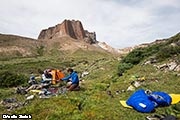
Cerro Colorado - camp. 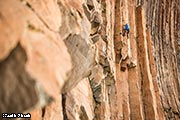
Coleman Blakeslee on Young Gaucho 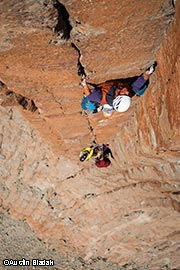
Matt Van Biene on the crux pitch of 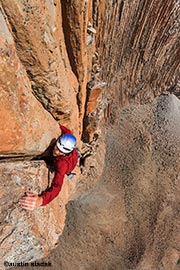
Tad McCrea in the last steep pitch of
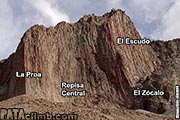
Cerro Colorado overview. 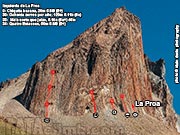
Left of La Proa,1- 4. 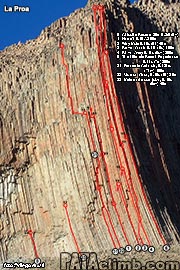
La Proa, 3 to 11 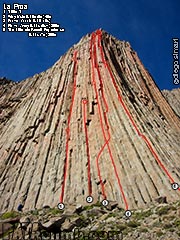
La Proa, routes 5 to 11.
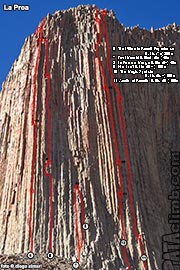
La Proa & right of La Proa, routes 11 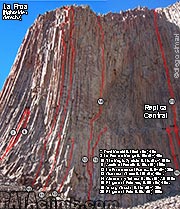 La Proa-right side and Repisa Central,
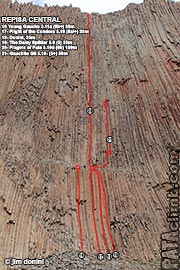
Repisa Central, routes 25 to 31. 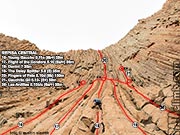
Repisa Central, routes 25 to 31.
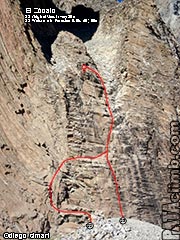
El Zócalo, routes 32 and 33. 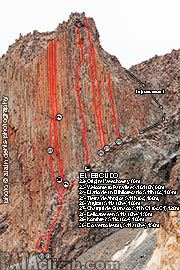
El Zócalo & El Escudo, routes 32 to 41 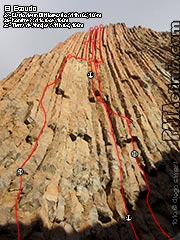
El Escudo, routes 34 and 36. 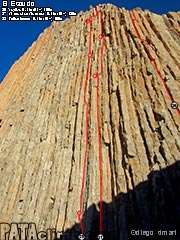
El Escudo, routes 38 to 41. |
SITEMAP
If you find this web page useful, please consider making a donation
CLIMBING AREAS |
KNOWLEDGEDISCLAIMER COPYRIGHT CONTACT DONATE |
Climbing is dangerous, take responsibility, climb at your own risk. © 2010 Rolando Garibotti. All rights reserved.